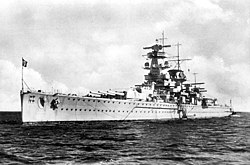Interception
Having intercepted and sunk the cargo liner Doric Star on 2 December off South West Africa, at 05:18hrs [2] on the morning of Sunday 3 December 1939 by the use of its FMG G(gO) "Seetakt" Radar the Graf Spee made contact with the Tairoa which was under the command of her Master, Captain William Starr, and was en-route from Brisbane to London laden with meat, lead, wool and other general cargo. [1] [2]
At the time the standard operating procedure of Kapitän Langsdorff was to approach his quarry head on, at maximum speed, and to fly the French Ensign. On this particular occasion, Langsdorff was aided by the additional disguise of an extra funnel and main turret, which had been added during the previous rendezvous with the Altmark . [1] [2]
Langsdorff made visual acquisition with the Tairoa at a distance of approximately 5 nautical miles (9.3 km; 5.8 mi) with Graf Spee positioned just off Taiora's beam. As a consequence of the Admiralty information, Captain Starr was fully aware of the existence of a surface raider in the area and so he was on the bridge when a vessel was sighted. This vessel was not recognised as the Graf Spee as she was bow on (in line with Langsdorff's tactics) and her flag did not show. When the flag could be seen it proved to be a small Ensign, deeply blackened by smoke, and flying from the dummy funnel which had been added to Graf Spee. [1] [2] [3] [4]
When Graf Spee was at about 2 nautical miles (3.7 km; 2.3 mi) she proceeded to hoist a flag signal stating "I am coming to board you." This was followed by a further two signals that were not read. On the Tairoa's bridge Capt. Starr was still unaware of his predicament until at just under 1 nautical mile (1.9 km; 1.2 mi) it could be clearly seen by Starr that the approaching ship had all her big guns trained on the Tairoa. There was also a banner clearly displayed on the superstructure of the Graf Spee that read: "Stop wireless or I open fire!" [1] [2] Onboard the Tairoa it was decided to ignore the banner and her Wireless Officer, Patrick Cummins, [2] continued to broadcast the R-R-R signal ("I am being attacked by a raider") as well as giving the ship's position.
The transmission was clearly heard onboard Graff Spee and resulted in Langsdorff giving an order for Graf Spee to open fire on the mastheads of the Tairoa which was carried out by use of her secondary armament of 15 cm (5.9 in) SK C/28 guns, destroying the wireless aerials. Despite the situation Cummins was able to piece together a rudimentary wireless set and continued to transmit, which resulted in a further salvo from Graf Spee.
Admiral Graf Spee was under strict orders to comply with prize law. This required her to search any intercepted a ship for contraband and to ensure the safety of the captured ship's crew. If her commander decided to sink a captured ship, he would also have to ensure its crew was safely evacuated prior to any action.
Kapitän Langsdorff sent a boarding party to Tairoa. The party took Captain Starr prisoner together with his crew, three of whom had been injured by shrapnel, [3] and transferred them to Admiral Graf Spee.
Approximate position of
Tairoa's wreck

